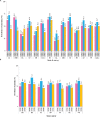Time trends in prevalence of anaemia in pregnancy
- PMID: 29923516
- PMCID: PMC6022385
- DOI: 10.4103/ijmr.IJMR_1730_16
Time trends in prevalence of anaemia in pregnancy
Abstract
Background & objectives: : The prevalence of anaemia in pregnancy in India is among the highest in the world. In the last two decades, several national surveys have estimated haemoglobin levels in pregnant women. In this study, data from these surveys were analyzed to find out changes, if any, in prevalence of anaemia in pregnancy.
Methods: : National and State-level estimates on the prevalence of anaemia were tabulated from the reports of the National Family Health Survey (NFHS) 2, NFHS 3, Fact Sheets of NFHS 4 and District Level Household Survey (DLHS) 2. Unit level data from DLHS 4 and Annual Health Survey Clinical Anthropometric and Biochemical component (AHS CAB) were obtained and State level prevalence of different grades of anaemia was estimated. Time trends in the prevalence of anaemia and different grades of anaemia were assessed from these surveys.
Results: : NFHS 2, 3 and 4 reported relatively lower prevalence of anaemia as compared to DLHS and AHS CAB. There was not much change in the prevalence or severity of anaemia between NFHS 2, 3 and 4. There was substantial reduction in the prevalence and severity of anaemia in all States except Uttarakhand between DLHS 2 and 4 and DLHS 2 and AHS CAB.
Interpretation & conclusions: : There was a reduction in the prevalence and severity of anaemia in the last 15 years. The two-pronged strategy of increasing iron intake (dietary diversification and use of iron-fortified iodized salt) in all the population and testing, and detecting and treating pregnant women with anaemia will accelerate the pace of reduction in anaemia.
Keywords: Anaemia; grades of anaemia; pregnancy; prevalence; time trends.
Conflict of interest statement
None
Figures







Comment in
-
Reduction in prevalence of anaemia in pregnant women.Indian J Med Res. 2018 Sep;148(3):345-346. doi: 10.4103/ijmr.IJMR_1429_18. Indian J Med Res. 2018. PMID: 30425227 Free PMC article. No abstract available.
-
Authors' Response.Indian J Med Res. 2018 Sep;148(3):346-347. doi: 10.4103/0971-5916.245301. Indian J Med Res. 2018. PMID: 30425228 Free PMC article. No abstract available.
References
-
- World Health Organization. Geneva: WHO; 2015. [accessed on October 20, 2016]. The global prevalence of anaemia in 2011. Available from: http://www.who.int/nutrition/publications/micronutrients/global_prevalen...
-
- Stevens GA, Finucane MM, De-Regil LM, Paciorek CJ, Flaxman SR, Branca F, et al. Global, regional, and national trends in haemoglobin concentration and prevalence of total and severe anaemia in children and pregnant and non-pregnant women for 1995-2011: A systematic analysis of population-representative data. Lancet Glob Health. 2013;1:e16–25. - PMC - PubMed
-
- Kozuki N, Lee AC, Katz J Child Health Epidemiology Reference Group. Moderate to severe, but not mild, maternal anemia is associated with increased risk of small-for-gestational-age outcomes. J Nutr. 2012;142:358–62. - PubMed
-
- Steer PJ. Maternal hemoglobin concentration and birth weight. Am J Clin Nutr. 2000;71:1285S–7S. - PubMed
-
- Sharma A, Patnaik R, Garg S, Ramachandran P. Detection & management of anaemia in pregnancy in an urban primary health care institution. Indian J Med Res. 2008;128:45–51. - PubMed
MeSH terms
Substances
LinkOut - more resources
Full Text Sources
Other Literature Sources
